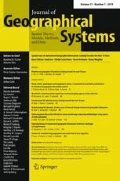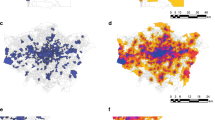Abstract
The modifiable areal unit problem (MAUP) is a problem by which aggregated units of data influence the results of spatial data analysis. Standard GWR, which ignores aggregation mechanisms, cannot be considered to serve as an efficient countermeasure of MAUP. Accordingly, this study proposes a type of GWR with aggregation mechanisms, termed area-to-point (ATP) GWR herein. ATP GWR, which is closely related to geostatistical approaches, estimates the disaggregate-level local trend parameters by using aggregated variables. We examine the effectiveness of ATP GWR for mitigating MAUP through a simulation study and an empirical study. The simulation study indicates that the method proposed herein is robust to the MAUP when the spatial scales of aggregation are not too global compared with the scale of the underlying spatial variations. The empirical studies demonstrate that the method provides intuitively consistent estimates.










Similar content being viewed by others
Notes
The effective range of the Gaussian function is defined by \( r\sqrt 3 \).
References
Berrocal VJ, Gelfand AE, Holland DM (2010) A spatio-temporal downscaler for outputs from numerical models. J Agric Biol Environ Stat 15(2):176–197
Berrocal VJ, Gelfand AE, Holland DM (2012) Space–time data fusion under error in computer model output: an application to modeling air quality. Biometrics 68(3):837–848
Butkiewicz T, Ross K (2010) Alleviating the modifiable areal unit problem within probe-based geospatial analyses. Comput Graph Forum 29(3):923–932
Cressie N (1993) Statistics for spatial data. Wiley, New York
Cressie N (1996) Change of support and the modifiable areal unit problem. Geogr Syst 3(2–3):159–180
Farber S, Páez A, Volz E (2009) Topology and dependency tests in spatial and network autoregressive models. Geogr Anal 41(2):158–180
Finley AO (2011) Comparing spatially-varying coefficients models for analysis of ecological data with non-stationary and anisotropic residual dependence. Methods Ecol Evol 2(2):143–154
Fisher PF, Langford M (1996) Modeling sensitivity to accuracy in classified imagery: a study of areal interpolation. Prof Geogr 48(3):299–309
Fotheringham S, Brunsdon C, Charlton M (2002) Geographically weighted regression: the analysis of spatially varying relationships. Wiley, New York
Fuentes M, Raftery AE (2005) Model evaluation and spatial interpolation by Bayesian combination of observations with outputs from numerical models. Biometrics 61(1):36–45
Gelfand AE (2010) Misaligned spatial data: the change of support problem. In: Gelfand AE, Diggle PJ, Guttorp P, Fuentes M (eds) Handbook of spatial statistics. CRC Press, Boca Raton, pp 517–539
Gelfand AE (2012) Hierarchical modeling for spatial data problems. Spat Stat 1:30–39
Goovaerts P (2008) Kriging and semivariogram deconvolution in the presence of irregular geographical units. Math Geosci 40(1):101–128
Gotway CA, Young LJ (2002) Combining incompatible spatial data. J Am Stat Assoc 97(458):632–648
Gotway CA, Young LJ (2007) A geostatistical approach to linking geographically aggregated data from different sources. J Comput Graph Stat 16(1):115–135
Haining RP, Kerry R, Oliver MA (2010) Geography, spatial data analysis, and geostatistics: an overview. Geogr Anal 42(1):1–31
Harris P, Brunsdon C, Fotheringham AS (2011) Links, comparisons and extensions of the geographically weighted regression model when used as a spatial predictor. Stoch Environ Res Risk Assess 25(2):123–138
Kyriakidis PC (2004) A geostatistical framework for area-to-point spatial interpolation. Geogr Anal 36(3):259–289
Kyriakidis PC, Yoo E-H (2005) Geostatistical prediction and simulation of point values from areal data. Geogr Anal 37(2):124–151
Lam N-S (1983) Spatial interpolation methods: a review. Am Cartogr 10(2):129–149
Lee SJ, Yeatts KB, Serre ML (2009) A Bayesian maximum entropy approach to address the change of support problem in the spatial analysis of childhood asthma prevalence across North Carolina. Spat Spatiotemporal Epidemiol 1(1):49–60
LeSage JP, Pace RK (2009) Introduction to spatial econometrics. Chapman and Hall/CRC, Boca Raton
Müller WG (1998) Collecting spatial data: optimum design of experiments for random fields. Physica-Verlag, Heidelberg
Nagle NN, Sweeney SH, Kyriakidis PC (2011) A geostatistical linear regression model for small area data. Geogr Anal 43(1):38–60
Odoi A, Martin W, Michel P, Holt J, Middleton D, Wilson J (2003) Geographical and temporal distribution of human giardiasis in Ontario Canada. Int J Health Geogr 2:5
Openshaw S (1984) The modifiable areal unit problem. Geo Books, Norwich
Openshaw S, Rao L (1994) Algorithms for reengineering 1991 Census geography. Environ Plan A 27(3):425–446
Openshaw S, Taylor P (1979) A Million or so correlation coefficients: three experiments on the modifiable areal unit problem. In: Wrigley N (ed) Statistical methods in the spatial sciences. Pion, London, pp 127–144
Páez A, Uchida T, Miyamoto K (2002) A general framework for estimation and inference of geographically weighted regression models: 1. Location-specific kernel bandwidths and a test for locational heterogeneity. Environ Plan A 34(4):733–754
Páez A, Long F, Farber S (2008) Moving window approaches for hedonic price estimation: an empirical comparison of modeling techniques. Urban Stud 45(8):1565–1581
Páez A, Farber S, Wheeler D (2011) A simulation-based study of geographically weighted regression as a method for investigating spatially varying relationships. Environ Plan A 43(12):2992–3010
Reynolds HD (1998) The modifiable areal unit problem: empirical analysis by statistical simulation. Thesis, University of Toronto
Sahu SK, Gelfand AE, Holland DM (2010) Fusing point and areal level space–time data with application to wet deposition. J R Stat Soc C Appl Stat 59(1):77–103
Schabenberger O, Gotway CA (2005) Statistical methods for spatial data analysis. Chapman and Hall/CRC, Boca Raton
Siffel C, Strickl MC, Gardner BR, Kirby RS, Correa A (2006) Role of geographic information systems in birth defects surveillance and research. Birth Defects Res A Clin Mol Teratol 76(11):825–833
Swift A, Liu L, Uber J (2008) Reducing MAUP bias of correlation statistics between water quality and GI illness. Comput Environ Urban Syst 32(2):134–148
Tagashira N, Okabe A (2002) The modifiable areal unit problem in a regression model whose independent variable is a distance from a predetermined point. Geogr Anal 34(1):1–19
Tranmer M, Steel D (1998) Using census data to investigate the causes of the ecological fallacy. Environ Plan A 30(5):817–831
Vichiensan V, Páez A, Kawai K, Miyamoto K (2006) Nonstationary spatial interpolation method for urban model development. Transp Res Rec 1977:103–111
Ware R, Lad F (2003) Approximating the distribution for sums of products of normal variables. University of Canterbury, Christchurch
Wheeler D (2007) Diagnostic tools and a remedial method for collinearity in geographically weighted regression. Environ Plan A 39(10):2464–2481
Wheeler D (2009) Simultaneous coefficient penalization and model selection in geographically weighted regression: the geographically weighted lasso. Environ Plan A 41(3):722–742
Wheeler D, Páez A (2010) Geographically weighted regression. In: Fischer MM, Getis A (eds) Handbook of applied spatial analysis. Springer, Berlin, pp 461–486
Wheeler D, Tiefelsdorf M (2005) Multicollinearity and correlation among local regression coefficients in geographically weighted regression. J Geogr Syst 7(2):161–187
Wong D (2009) The modifiable areal unit problem (MAUP). In: Fotheringham AS, Rogerson PA (eds) The SAGE handbook of spatial analysis. SAGE, London, pp 105–124
Young LJ, Gotway CA (2007) Linking spatial data from different sources: the effects of change of support. Stoch Environ Res Risk Assess 21(5):589–600
Young LJ, Gotway CA, Kearney G, Duclos C (2009a) Assessing uncertainty in support-adjusted spatial misalignment problems. Commun Stat Theory Methods 38(16–17):3249–3264
Young LJ, Gotway CA, Yang J, Kearney G, Duclos C (2009b) Linking health and environmental data in geographical analysis: it’s so much more than centroids. Spat Spatiotemporal Epidemiol 1(1):73–84
Acknowledgments
We thank Dr. Haoying Wang (Pennsylvania State University, United States) for his helpful comments at the VII World Conference of the Spatial Econometrics Association. This work was supported by two Grants-in-Aid for Scientific Research from JSPS (Research Project Numbers: 23360219 and 24241053). Further, this paper fulfills the criteria of the Global Climate Risk Management Strategies (S10) project.
Author information
Authors and Affiliations
Corresponding author
Appendix 1: ATP GWR for the extensive variables
Appendix 1: ATP GWR for the extensive variables
A must be determined by considering the volume-preserving property for the extensive variables. In other words, \( {\bar{\mathbf{y}}} \) = Ay must hold under the condition that the elements in y are extensive variables. For example, suppose that the population in an aggregated unit a is \( \bar{y}_{a} \) and unit a comprises two disaggregated units d and d′; then, \( {\bar{\mathbf{y}}} \) = Ay is expressed as
Equation (6) merely states that \( \bar{y}_{a} = Y_{d} + Y_{{d^{{\prime }} }} \) must equal A a,d Y d + A a,d′ Y d′. This is satisfied by defining A d and A d′ as ones. In general, \( {\bar{\mathbf{y}}} \) = Ay is fulfilled by defining A a,d as follows:
ATP GWR for the extensive variables is thus defined by defining A a,d , which was defined in Eq. (7), as shown in Eq. (19). In this case, the variance of the error term is scaled by the number of disaggregated units in each aggregated unit.
Rights and permissions
About this article
Cite this article
Murakami, D., Tsutsumi, M. Area-to-point parameter estimation with geographically weighted regression. J Geogr Syst 17, 207–225 (2015). https://doi.org/10.1007/s10109-015-0212-8
Received:
Accepted:
Published:
Issue Date:
DOI: https://doi.org/10.1007/s10109-015-0212-8
Keywords
- Modifiable areal unit problem
- Geographically weighted regression
- Change of support problem
- Geostatistics




